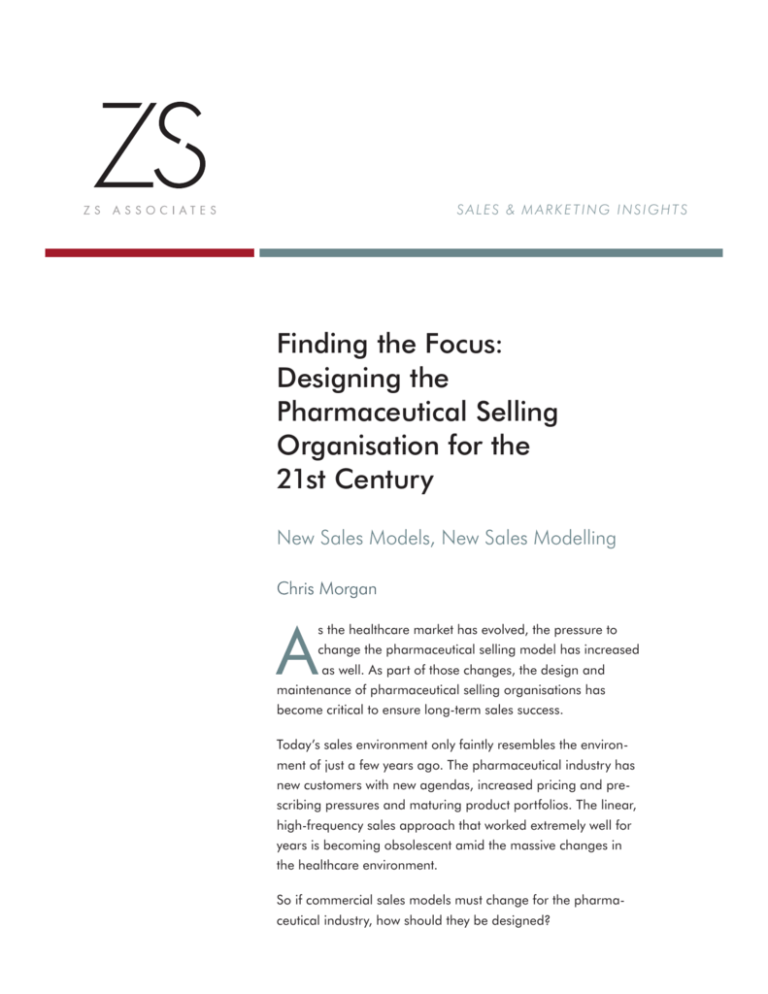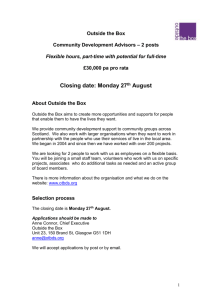
S A LES & M A RKE TING INSIGHTS
Finding the Focus:
Designing the
Pharmaceutical Selling
Organisation for the
21st Century
New Sales Models, New Sales Modelling
Chris Morgan
A
s the healthcare market has evolved, the pressure to
change the pharmaceutical selling model has increased
as well. As part of those changes, the design and
maintenance of pharmaceutical selling organisations has
become critical to ensure long-term sales success.
Today’s sales environment only faintly resembles the environment of just a few years ago. The pharmaceutical industry has
new customers with new agendas, increased pricing and prescribing pressures and maturing product portfolios. The linear,
high-frequency sales approach that worked extremely well for
years is becoming obsolescent amid the massive changes in
the healthcare environment.
So if commercial sales models must change for the pharmaceutical industry, how should they be designed?
The Multidimensional Sales Force
In order to build a 21st century sales model, pharmaceutical sales
organisations first need to evaluate their current goals and strategies.
The answers to several questions underpin the direction a selling organisation takes:
What are the company’s desired customer outcomes?
What must the sales force do in order to achieve its desired business outcomes, and with which customers?
What activities or products will deliver these outcomes?
How is each part of the organisation best suited to meet
these goals?
Until recently, large numbers of independent, high-value physicians
dominated the healthcare market. They made frequent purchasing
decisions, had low switching costs and did not stick to a single product
or manufacturer over time.
As a consequence, large primary care sales organisations delivered
simple messages frequently to a targeted group of general practitioners. The underlying logic for sale force design was one-dimensional:
Size dominated coverage and frequency; coverage and frequency
drove share of voice; share of voice determined market share.
The market today is more complex: New customers have new needs,
and the balance of power in decision making is moving away from
doctors and toward healthcare policy makers and insurers. As this happens, sale force design takes on several new dimensions—the single
dimension of sales force size no longer is dominant. Instead, the new
sales model is typically centres around the Key Account Manager, who
marshals a local account team to work with a network of customers.
Local account teams combine health economic executives, field medics,
finance managers and product management and others, together with
conventional representatives.
Because the new sales process is multidimensional, when designing the
model, management must take many additional factors into consideration. First, the different roles within the sales organisation (and not its
size) are the defining characteristic of the sales force. The customers
now comprise a more complex network of many different roles;
2
ZS Associates
the structure that connects these roles and the sales force’s capabilities
are what makes the new model successful.
Next, delivering a frequency of sales calls is no longer the prime purpose of the sales force. Instead, the model emphasizes a combination
of different, interlocking activities that comprise a company’s market
offering. The roles of the local account teams are multifaceted and not
singularly focused on the number of sales calls made.
Finally, sales teams no longer seek customer “share of mind” but instead aim to build partnerships that add value and form the basis of a
sustainable, long-term relationship.
In short, pharmaceutical companies are seeking different customer
outcomes, and must address more complex customer needs, with a
broader range of sales force “levers.”
Table 1 and the accompanying figure compare the “old” model with the
multidimensional nature of the emerging model replacing it. A structure
that requires multiple roles and points of contact has replaced the linear,
salesperson-to-doctor relationship based on frequency of sales calls. The
multidimensional nature of the new model is shown as well.
Old world
Index value
Table 1.
Old-World Versus
New-World Sales Model
Customer
outcomes
Activities
Sales force
design
dimensions
3
New world
Market share
Sales
Partnership
Trust
Sustainability
Market share
Product knowledge
Share of mind
Improved business
performance
Improved healthcare
outcomes
Operational excellence
Control
Calls
Partnership
Value-added
programmes
Size
Resource allocation
Capabilities
Roles
Structure
Implementation
ZS Associates
Company
results
Customers
Figure 1. Drug companies must
keep multiple dimensions of the sales model
in balance in order to be
successful.
(roles and
needs)
Selling roles
and
structure
Market
offering
Capabilities
(individual and
organisation)
Pressure Points in Complex Selling Organisations
Because the system is more complex, it is also more volatile, and there
are certain pressure points where an improperly designed sales model
could break down. From the experiences of pharmaceutical companies
that have tried transforming their sales model, we can identify some of
those pressure points, illustrated in Figure 2.
Company
results
Disconnects with
customers and their
needs
Figure 2. Various pressure points
can cause a multidimensional sales model
to break down.
Customers
(roles and
needs)
Selling roles
and
structure
Market
offering
Capabilities
(individual and
organisation)
4
Disconnects of
structure
Disconnects of
capabilities
ZS Associates
In our experience, common disconnects arise as these multidimensional
sales organisations experience growing pains. These deal with customers, the selling organisation’s capabilities, and the sales structure itself.
Disconnects With Customers
The organisation’s selling model is well planned, but little
thought has been put into the customer’s value proposition.
In this case, the company has built a viable sales structure, but it
has not determined what value customers will derive from the new
model. Key customers see new people with impressive-sounding
titles on their business cards, but they do not see how it helps their
business.
The selling organisation is not aligned with customers.
Customers operate as a loosely networked local health economy;
the boundaries of these networks may not be clear, and the pharmaceutical company does not understand how these networks
relate to the sales structure. There is no alignment between the
sales organisation and customers.
There is an insufficient understanding of new customer roles
and needs. The drug firm’s sales organisation assumes what customers want. This results in customers that remain segmented on
the basis of their value to the pharmaceutical firm, not the firm’s
potential value to customers.
Disconnects With Capabilities
New roles generate competency profiles that are too demanding. The company cannot find the right candidates, so
compromise canddiates fill important roles..
Because they lack the required competencies, salespeople
cannot deliver what the new model promises. This is often
caused by a combination of a new sales model with the same old
people.
Disconnects With Structure
Overloaded Key Account Managers. KAMs may be assigned
too many direct reports in order keep line management clear.. The
role then mutates into a first-line managerial position that ignores
account needs.
5
ZS Associates
Dysfunctional matrix management. A lack of clarity over roles
confuses the sales force, breaking down teams’ coherence, which
is needed to successfully deliver the market offering.
Organisational systems and processes do not support the
new sales model. For example, the budgeting process may make
it impossible for KAMs from accessing their discretionary budget
fast enough to meet customer needs.
Finding the Focus
In order to create a coherent, focused organisation, it is necessary to
design selling models that align across the critical dimensions described in Figure 3.
Company
results
Customers
(roles
(roles and
and
needs)
needs)
Figure 3. The new selling
model needs to be
aligned across critical
dimensions.
Market
offering
Commercial
Organisation
Design
Selling roles
and
structure
Capabilities
(individual and
organisation)
In our experience, three key features of modern sales model design will
separate success from failure:
1. A holistic, customer-centred approach to design
Strong sales model design incorporates all the dimensions described above, using the same fundamental logic throughout.
The customer provides the ideal, “unifying” driver. Customers are
segmented according to needs and roles in the buying process.
6
ZS Associates
Market offerings—and therefore activities—are mapped to customer needs; roles are mapped to market offerings and customer
segments. Finally, roles need to be organised into a structure that
aligns with customers (and a structure that is aligned internally,
with itself).
2. A multi-issue approach to roles
Roles in complex sales organisations cannot be designed purely on
the basis of the workload; the workload needs to be balanced with
bandwidth requirements (i.e., the complexity of the tasks) and the
skills required of the role.
Bandwidth, not workload, typically limits complex jobs such as
KAMs. Anybody who has spent time managing multiple projects simultaneously will be familiar with this situation: “I don’t understand
it,” according to one KAM. “This role doesn’t have that much work
associated with it, but for some reason I feel stressed the whole
time, and don’t seem to be able to keep on top of everything.”
3. Implementation integration
A good strategy without implementation is worthless.
Implementation planning needs to permeate the process from the
beginning—not just the end. A pharmaceutical sales organisation
cannot develop a strategy and a structure and only then consider
how it will work in practice.
This is a difficult balancing act to pull off, requiring a combination
of customer understanding, analytical know-how and operational
experience.
However, the benefits are enormous. We have seen instances in which
better alignment of the sales force to customers can reduce the cost of
sales 10% to 30%. Better design of KAM roles can increase effective
coverage of key accounts 50%, while rigorous selection of salespeople
based on their capabilities can reduce the adoption time of a new sales
model 80%..
The pressures facing drug companies are not hypothetical concerns,
nor are any pharmaceutical firms immune from them. Building a sales
organisation based on the interactions of multiple dimensions will
not remove these pressures, but can help a pharmaceutical company
adapt—and garner new sales and better customer relationships in the
process.
7
ZS Associates
About ZS Associates
ZS Associates is a global management consulting firm specializing
in sales and marketing consulting, capability building and outsourcing.
The firm has more than 1,000 professionals in 17 offices around the
world, and has assisted more than 700 clients in 70 countries.
ZS consultants combine deep expertise in sales and marketing with
rigorous, fact-based analysis to help business leaders develop and
implement effective sales and marketing strategies that measurably
improve performance.
As the largest global consulting firm focused on sales and marketing, ZS Associates has experience across a broad range of industries,
including medical products and services, pharmaceuticals, biotechnology, high tech, telecommunications, transportation, consumer products
and financial services.
For more information on ZS Associates, call +1 847.492.3602 or visit
www.zsassociates.com.
About the Author
Chris Morgan is a Principal with ZS Associates based in London and
Frankfurt. He has worked on a wide range of sales and marketing
strategy issues, including go-to-market strategy, sales force effectiveness, sales organisation design, portfolio strategy, opportunity assessment and targeting. In addition, Chris has worked on numerous global
and regional initiatives with pharmaceutical companies to achieve
results through account management. He holds a Ph.D. in materials
science and a B.A. in natural science from Cambridge University.
ZS Associates
www.zsassociates.com
inquiry@zsassociates.com
+1 847 492 3602
© 2009 ZS Associates, Inc.
05-09
All Rights Reserved
All trademarks within this document are either
the property of ZS Associates or their licensors.









